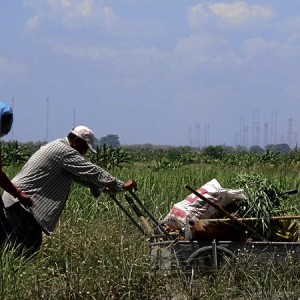
The Asia Rice Foundation Philippines (ARF) is pushing for the greater use of machinery in farms, particularly in rice lands, with the local grains sector hobbling in the wake of destructive typhoons. INQUIRER FILE PHOTO
MANILA, Philippines—The Asia Rice Foundation Philippines (ARF) is pushing for the greater use of machinery in farms, particularly in rice lands, with the local grains sector hobbling in the wake of destructive typhoons.
The Department of Agriculture has put farm damage due to Supertyphoon ‘Yolanda’ at P9.73 billion, including some P2.33 billion worth of palay.
Latest data from DA’s monitoring unit show that Yolanda ravaged 77,476 hectares of rice farms—in the Visayas, Bicol region and the Mindoro areas—where 143,774 metric tons of palay was expected to be harvested.
“The need to mechanize local farms is undeniably strong,” ARF chair Santiago R. Obien said in a statement.
Considering that typhoons and excessive rains threaten crops year after year, Obien said that the use of machinery would become more economical since it would help farm operations adhere to stricter schedules. On top of this, it would also help government’s push to ramp up national production toward the goal of self-sufficiency in food supply.
“The use of machines is definitely the better option now, like in the case of land preparation” as well as in harvesting the crops, Obien said.
He pointed out that after Typhoon “Santi” last October flattened the rice fields in Nueva Ecija and Isabela, combine harvesters were used because no laborers wanted to do the harvest.
Even then, while farm mechanization is a major part of the government’s food self-sufficiency program, it is still a sensitive topic because of an excess in labor supply and low wages in rural communities.
Still, the ARF said mechanization can reduce the labor cost in rice farms, which typically accounts for 45 percent of the total cost of production.
“We have to determine how we can both achieve higher farm mechanization rate and how to provide jobs for displaced farm workers,” he added.
According to Philippine Center for Post-Harvest Development and Mechanization, the country has a farm mechanization level averaging 1.23 horsepower per hectare. This is a “vast improvement” from the 0.52 hp/ha that was recorded in the 1990s.
In terms of crops, rice and corn farms are the most mechanized at 2 hp/ha.
The ARF is holding Friday in Quezon City its Annual Rice Forum, where more than a hundred agricultural engineers, farm experts and administrators from both the government and private sector are expected to attend.
This year’s forum is focused on issues related to the mechanization of rice farms. The forum also seeks to gather ideas that will be used to form a national agricultural mechanization road map.

